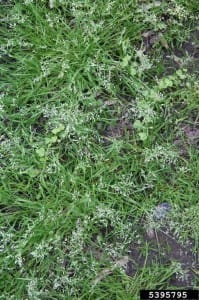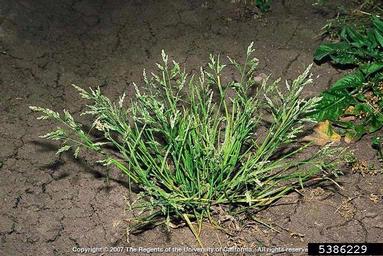
Postemergence Annual Bluegrass Control in Turf
Patrick McCullough, Extension Weed Specialist, University of Georgia
Edited from a more complete article which can be found here.
Contrary to its name, both annual (live for one season) and perennial (live for many seasons) populations of annual bluegrass may be found in turf. Annual bluegrass may out-compete other turf species during late fall and early spring. Annual bluegrass often dies from summer stresses but may survive if irrigated – especially the perennial biotypes
Postemergence Control (See Table 3)
Annual bluegrass may be selectively controlled with postemergence herbicides (Table 3).
Landscapers managing warm-season grasses have more options for selective postemergence annual bluegrass control than cool-season grasses.
Flazasulfuron (Katana), foramsulfuron (Revolver, Tribute Total), rimsulfuron (TranXit), and trifloxysufluron (Monument) are labeled for bermudagrass and zoyiagrass non-residential commercial lawns and other sites. Flazasulfuron and rimsulfuron are also labeled for use in centipedegrass. Efficacy of these herbicides generally increases under warm temperatures in spring compared to winter and non-ionic surfactants may enhance efficacy.
Pronamide (Kerb) is a restricted use herbicide for annual bluegrass control in non-residential bermudagrass, centipedegrass, St. Augustinegrass, seashore paspalum, and zoysiagrass. Pronamide is root-absorbed and must be watered in following applications. Pronamide efficacy is generally slower than most sulfonylureas and activity for annual bluegrass control may take approximately four to six weeks.
Atrazine (Aatrex, Bonus S, others) and simazine (Princep, WynStar, others) may also be applied to bermudagrass, centipedegrass, St. Augustinegrass, and zoysiagrass for selective postemergence annual bluegrass control. These herbicides often provide erratic control of annual bluegrass but may control other grassy and broadleaf weeds. Actively-growing bermudagrass is sensitive to atrazine and applications are recommended only during the late fall and winter months.
Dormant bermudagrass may be treated with nonselective herbicides, such as glyphosate (Roundup, Touchdown, others), glufosinate (Finale), and diquat (Reward). These herbicides will injure or kill existing vegetation, including annual bluegrass and managers should only spray at peak dormancy when no green turfgrass foliage is observable. Nonselective herbicides should only be applied to completely dormant bermudagrass and applications during early spring may delay greenup with significant turf injury.
Flumioxazin (Sureguard) is a new herbicide for pre- and postemergence annual bluegrass control but applications are limited to dormant bermudagrass only. Flumioxazin use after greenup or on other species are not recommended due to excessive injury potential.
Selective annual bluegrass control options in cool-season lawns are limited.
Ethofumesate (Prograss) controls established annual bluegrass in perennial ryegrass, tall fescue and dormant bermudagrass (see the current edition of the Georgia Pest Management Handbook). Two or three ethofumesate applications may be applied in late fall at three- to four-week intervals. Annual bluegrass control may be seen that fall, but control is usually observed the following spring. Annual bluegrass control with ethofumesate may vary greatly over years depending on environmental conditions.
Amicarbazone (Xonerate) is a new Photosystem II inhibitor, similar to triazine herbicides, but may be used in tall fescue lawns and other cool-season grasses. Applications of amicarbazone in Georgia are limited to springtime only to minimize injury to cool-season grasses. Warm-season turf is very tolerant to amicarbazone and may be treated at any seasonal timing.
Bispyribac-sodium (Velocity) has shown potential for selective annual bluegrass control in tall fescue and perennial ryegrass lawns. However, this herbicide is currently registered for creeping bentgrass and perennial ryegrass on golf courses and sod farms only. Spot treatments of nonselective herbicides are generally the most effective treatment regimen for annual bluegrass control in cool-season grasses.
Table 3. Efficacy of postemergence herbicides for annual bluegrass control in turfgrass.
| Common Name | Trade Name (Examples) | Efficacy |
| amicarbazone | Xonerate | F-G |
| atrazine | Aatrex, others | E |
| bispyribac-sodium | Velocity | F-G |
| flazasulfuron | Katana | G-E |
| flumioxazin | Sureguard | F-G |
| foramsulfuron | Revolver | E |
| glufosinate | Finale | E |
| glyphosate | Roundup, others | E |
| imazaquin | Image | P-F |
| metribuzin | Sencor | G |
| pronamide | Kerb | E |
| rimsulfuron | Tranxit | E |
| simazine | Princep, others | G-E |
| thiencarbazone + foramsulfuron + halosulfuron | Tribute Total | G-E |
| trifloxysulfuron | Monument | E |
E = Excellent (90 to 100%), G = Good (80 to 89%), F = Fair (70 to 79%), P = Poor (<70%).
For more information
Annual Bluegrass Control in Residential Turfgrass
Annual Bluegrass Control in Non-Residential Commercial Turfgrass

I have a heavy infestation of Poa annua typically around my trees and shrubs where I mow the Zoysia turf. Later in the year as the heat increases the Poa annua typically vanishes, however I wish to eradicate the pest now. As a homeowner, what is the best product to use and how quickly will I see the results? What for is best to use? Liquid, powder, granular? What rate?
James there’s an excellent bulletin on Annual Bluegrass Control in Residential Turfgrass authored by Extension Weed Specialist, Patrick McCullough. Be certain to read the part on chemical, postemergence control.